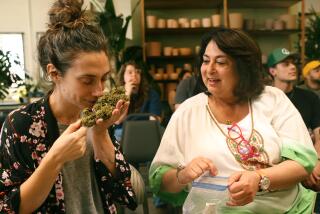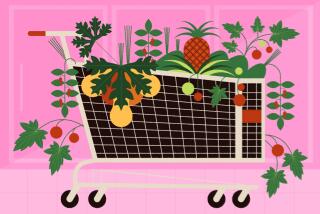Want a bumper crop of tomatoes? Listen to this guy
- Share via
David Freed spent most of his adult life in the restaurant business, but when he sold the 8th Street Grill, his University Park coffee shop, in 2007, he discovered there were plenty of other things to do with his time.
Such as unlocking the secrets to growing tons of tasty tomatoes.
In the fall he goes fishing in the Northwest or along the Mississippi. During the holidays he spends time with his four children and 10 grandchildren. And January through June, he becomes Dave the Tomato Guy, spreading his personal gospel to garden groups around Southern California.
“I wake up every day and do whatever I feel like doing,” said Freed. “I don’t lead an extravagant lifestyle, and I don’t need tons of money. It just makes me happy this time of year to tell people how to easily grow tomatoes.”
The Tomato Guy spent his early childhood on a dry land farm in Kansas until his family moved to Oregon and then Southern California. But no matter where they were, his parents always had a vegetable garden, and after Freed retired he began playing with techniques to see how he could improve his yields.
All Freed’s advice is home-tested and posted on his Grow Tomatoes Easily blog. All he asks is that people follow his instructions. (For more details visit his blog.)
“You can do it your way if you want,” he said, “and be known as a bonsai tomato person, growing tiny plants with tiny tomatoes, But if you want a lot of tomatoes, follow the suggestions I give you.”
Ensure your plants get sun
In Freed’s experience, cherry tomatoes need at least four hours of full sun a day, and bigger tomatoes need six to eight. “If you have at least six hours a day, you’ll be fine because you’re going to have a very ideal growing environment for those tomatoes,”
Pick high-yield varieties
Don’t be seduced by cool names or exotic colors. Many varieties taste delicious but only produce a few tomatoes per plant, Freed said. He prefers indeterminate varieties that grow like vines (requiring sturdy support cages) and includes a long list of good flavorful producers on his blog. Two of his top recommendations are heirloom varieties, ‘Brandywine’ and ‘Cherokee Purple,’ but he also includes several hybrids, including his favorites: ‘Better Boy’ and ‘Big Beef.’
Use potting soil, even in the garden
Freed plants in 15-to-20-gallon containers and in the ground, but either way he always uses a potting soil that lists sphagnum peat moss or peat moss as its first ingredient. For in-ground planting, dig a hole that’s 2 feet deep and 2 feet wide, discard the native dirt and fill the hole with your potting soil, which is designed to retain moisture, he said. “Most people do a lousy job with their soil, so this is probably the biggest improvement you can make to your soil this year.” One he recommends is Kellogg Organic Select Potting Mix, available at Costco for about $9 a 55-quart bag.
(NOTE: Peat moss has become controversial because of environmental concerns about depleting peatlands, so some gardeners use alternative products such as PittMoss, made from paper, or coconut coir to improve water retention in the soil. But those products can be more expensive, Freed said, and are rarely the first ingredient in potting soils, so you’d have to mix your own, “something most people don’t want to do.”)
Plant at the proper time
Optimum planting time for Southern California is in the spring, after temperatures stay above 55 degrees, but before it gets super hot, he said. June is still an OK time for planting, he said, as long as temperatures are under 85 degrees. Much hotter than that and the plant goes into survival mode and won’t set fruit.
Feed with liquid fertilizers, not dry
Plants take up liquid fertilizers more quickly than dry, according to Freed, so you’ll see results quickly. Choose a liquid fertilizer for vegetables balanced with equal parts of NPK — nitrogen (N), phosphate (P) and potassium (K), “and always follow the directions on the package.” Two he recommends are Kellogg Organic Plus Fish & Kelp Fertilizer and Miracle-Gro Water Soluble Plant Food Vegetables & Herbs.
Water slow and deep
Tomatoes use 2 to 3 gallons of water a day, so it’s imperative the soil around their roots stay moist, Freed said. He recommends watering each plant slowly and deeply a couple times a week, then use a moisture meter in between to be sure the soil is moist. If you’re planting in a container, water slowly until the water comes out the hole of the pot. If the plant is in the ground, slowly fill the planting hole so the water goes deep into the soil. For taller plants, Freed buries perforated, 4-inch-diameter pipes about 18 to 20 inches in the ground and fills them with water once or twice per session to force moisture deep into the soil. His blog has instructions for creating your own.
More to Read
Sign up for The Wild
We’ll help you find the best places to hike, bike and run, as well as the perfect silent spots for meditation and yoga.
You may occasionally receive promotional content from the Los Angeles Times.











